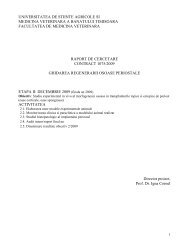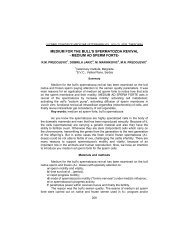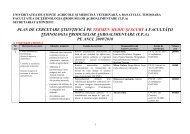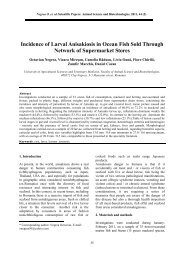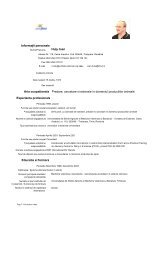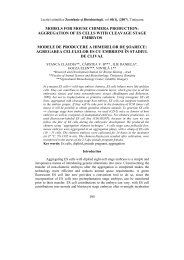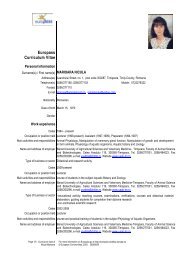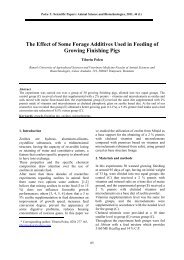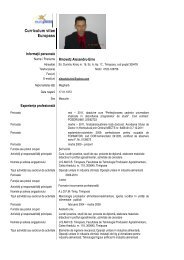journal of linguistic studies
journal of linguistic studies
journal of linguistic studies
Create successful ePaper yourself
Turn your PDF publications into a flip-book with our unique Google optimized e-Paper software.
introduce the target language culture background step by step; open some subjects<br />
covering its history, society, humanistic community, etc. Lectures, books or <strong>journal</strong>s in<br />
these fields will be also helpful. All the approaches above are supported by teachers and<br />
researchers. But to the errors in this aspect, they could reach a conclusion, and the<br />
correction varies from person to person.<br />
Discussing further in class, you could not elaborate due to limited time. Dealing with<br />
the errors later, it is hard for you to arouse full attention, perhaps the students have<br />
already left them out <strong>of</strong> mind. To the intra-lingual interference, we should emphasize<br />
grammar study, sentence structure, conduct drills repeatedly, and ask students to pay<br />
attention to the accuracy <strong>of</strong> their speech. The errors produced in this stage ought to be<br />
corrected, which is advocated by most teachers. But how to do that and when to do that<br />
may have some disagreements. Pointing out errors on the spot, you have to interrupt the<br />
student, as a result, he could not continue his representation as he has planned, and he<br />
may even develop negativity. Dealing with them later, they will not leave a deep<br />
impression on him.<br />
To the non-<strong>linguistic</strong> interference, most people share the view that such errors need<br />
not to be corrected, since the speaker are shy, nervous, tired, etc. They will disappear as<br />
time passes. While there are still a minority insist that they should be corrected as well,<br />
because repeated and unconscious commitments will lead to “error-fossil”.<br />
4. A COMMON SENSE APPLICATION TO ERRORS IN SPOKEN ENGLISH<br />
This approach is composed <strong>of</strong> five stages: discovery, isolation, explanation,<br />
experimentation, and learning-acquisition. And it is student-centred. Traditionally the<br />
speaking class is teacher-centred. Most time is devoted to teachers’ inquiry.<br />
Comparatively this approach provides students with lots <strong>of</strong> opportunities to speak in<br />
class. It is minimally disruptive to both the flow <strong>of</strong> the lesson and student motivation.<br />
In such classrooms teachers will play a role as an organizer and listener. In the<br />
process <strong>of</strong> representation by the student, the teacher could listen quietly and make a note<br />
<strong>of</strong> the errors. He needn’t point them out on the scene. After all the representations, he<br />
could focus on some. According to the coverage and frequency <strong>of</strong> errors, he may have a<br />
definite object in view. In class, there could be many forms <strong>of</strong> communication, such as<br />
dictation, question-answer, brief interview, dialogue, group work, etc. In any activity,<br />
errors are inevitable. The teacher must listen carefully in order to identify and note errors.<br />
He could put errors under different student respectively. A sentence containing errors<br />
should be isolated for subsequent treatment. It is good to keep that whole sentence, better<br />
with the previous or the next one. If the same kind <strong>of</strong> error appears again, he could just<br />
mark a certain sign, showing its repeated occurrence. In this stage he should discriminate<br />
“mistake” and “error”.<br />
Errors are classified along two lines: global or local, global errors can be defined as<br />
those that affect comprehension, while local errors, though <strong>linguistic</strong>ally non- or substandard,<br />
do not break down communication, but cause misunderstanding somehow.<br />
Errors actually involve language that has not been acquired or has been incorrectly<br />
acquired, while mistakes are idiosyncratic, careless, and inconsistent. In the daily<br />
teaching, it is not easy to tell them apart.<br />
Sometimes, the student will violate grammar rules, making some errors, but as the<br />
communication goes on, he may discover the errors himself, or find it with the help <strong>of</strong> his<br />
partner, and then he corrects them on his own. Under that situation, you couldn’t attribute<br />
38



